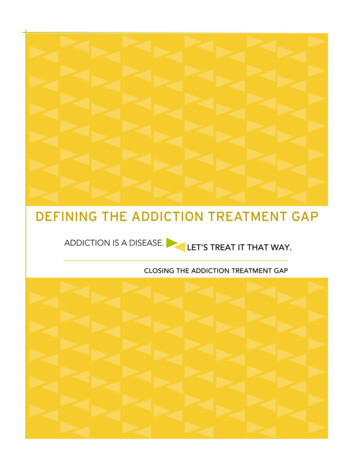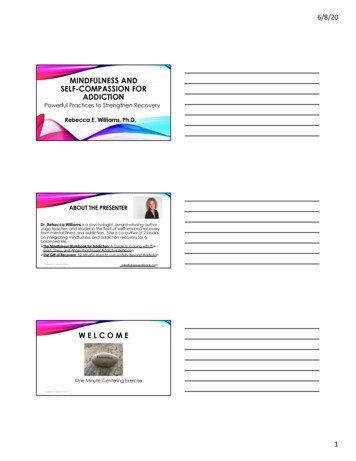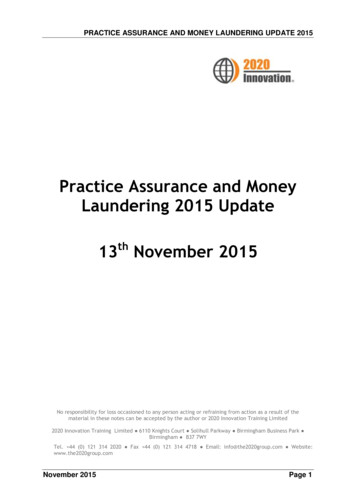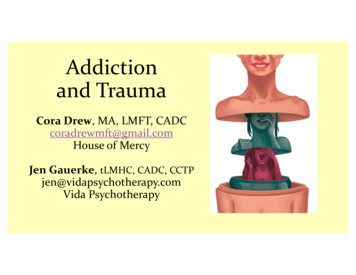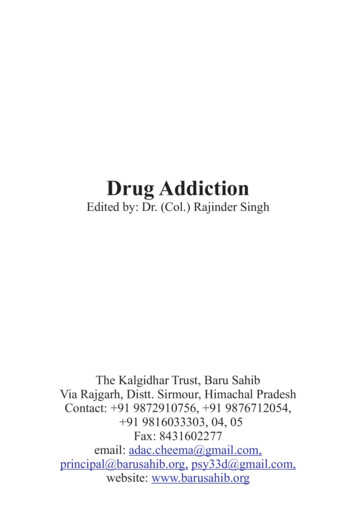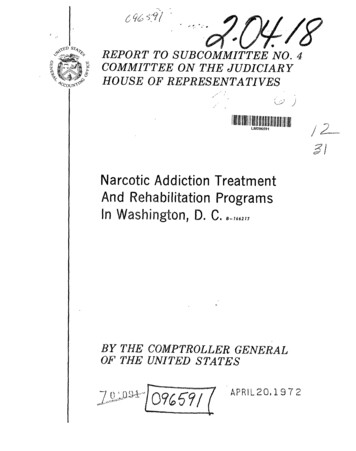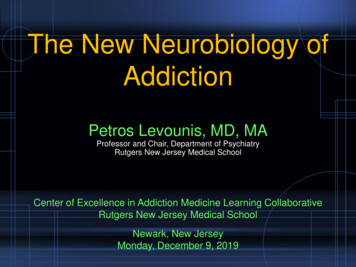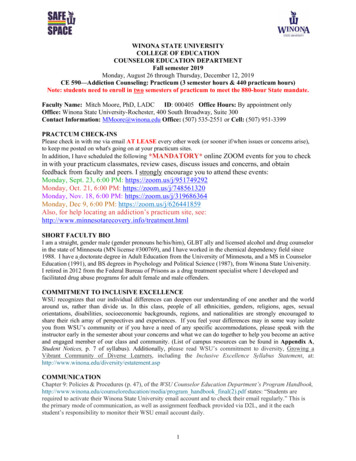
Transcription
A Guide to the CoreCompetencies for the Deliveryof Addiction Treatment ServicesTHE ADDICTIONTREATMENT PROVIDERQUALITYASSURANCE GUIDEBOOKVOICE VISION LEADERSHIP
TABLE OFCONTENTSCONTRIBUTORS3EXECUTIVE SUMMARY4THE GUIDELINES6A. Operations6E. Discharge and Continuing Care30Guideline A-1: Treatment Philosophy7Guideline E-1: Continuum of Care31Guideline A-2: Licensing9Guideline E-2: Discharge Planning32Guideline A-3: Accreditation10Guideline E-3: Atypical Discharges33Guideline A-4:Governance, Management, and Leadership11F. Outcomes Measures34Guideline A-5: Policies and Procedures12Guideline F-1: Tracking Patient Outcomes35Guideline A-6: Strategic Planning13Guideline A-7: Facilities14G. C ommunity Engagement, Public Relations,and Public Policy36B. Admissions and Patient Screening15Guideline G-1: Participation in the Community37Guideline G-2: Public Relations Strategy38Guideline B-1: Admissions Process16Guideline G-3: Public Policy Position39Guideline B-2:Patient Screening and Assessment17H. Marketing, Advertising, and Visibility40C. Employment, Training, and Credentialing18Guideline H-1: Marketing41Guideline C-1: Staff Training19Guideline H-2: Transparency42Guideline C-2: Professional Staff Credentials20Guideline H-3: Financial Remuneration43Guideline C-3: Salaries21Guideline H-4: Brand Integrity44Guideline C-4: Hiring Former Patients22Guideline H-5: Third-Party Marketing45D. Billing23I. Code of Ethics46Guideline D-1: Calculating Cost of Service24Guideline I-1: Code Compliance47Guideline D-2: Reasonable Billing Margins25Guideline D-3:Usual, Customary, and Reasonable Rates26Guideline D-4: Balance Billing and Receiving27Guideline D-5: Toxicology28Guideline D-6: Deductibles and Copays292
This Guidebook is produced byNational Association of AddictionTreatment Providers (NAATP) NAATP1120 Lincoln StreetSuite 1104Denver, CO RSNAATP StaffNAATP Quality AssuranceCommittee MembersGuidelineCommentary WritersMARVIN VENTRELL, JDCEOCARL KESTERCommittee ChairLakeside-Milam RecoveryCentersPAUL BACHARACHGateway RehabPETER THOMASQuality Assurance OfficerMARK DUNNDirector of Public PolicyCHELSEY CUSIMANO, MEdExecutive AdministratorJAY CROSSONCumberland HeightsFoundationANNIE PETERS, PhDHarmony FoundationTHOMAS BRITTON, DrPHGateway Foundation Alcohol& Drug Treatment CentersCADE SAURAGELa HaciendaTreatment CenterPHILIP EATONRosecrance Health NetworkJAY CROSSONCumberland HeightsFoundationKATHY STEADMAN, JDCoppersmith BrockelmanLawyersGARY FISHERCirque LodgeMARK DUNNNAATPMARK MISHEKHazelden Betty FordFoundationPHILIP EATONRosecrance Health NetworkMARV SEPPALA, MDHazelden Betty FordFoundationEDWARD DIEHLSeabrookCATHY PALMTully Hill Treatment& RecoveryDOUG TIEMANCaron Treatment CentersART VANDIVIERLa HaciendaTreatment Center Return to Table of ContentsSTAFFAmerican Society ofAddiction Medicine (ASAM)CATHY PALMTully Hill Treatment& RecoveryREBECCA FLOODAshley Addiction TreatmentPAUL HACKMANPavillonSHERRI LAYTONLa HaciendaTreatment CenterSCOTT MUNSONSundown M RanchPETER THOMASNAATPDOUG TIEMANCaron Treatment CentersART VANDIVIERLa HaciendaTreatment CenterMARVIN VENTRELL, JDNAATP3
EXECUTIVESUMMARYSince its founding in 1978, The National Association of AddictionTreatment Providers (NAATP and The National Association) hasserved as the national professional membership society andtrade organization for addiction treatment providers. In this role,The National Association serves the field of addiction treatmentthrough convening, education and training, the provisionof resources, member visibility, and public policy advocacy.During its 41-year existence, NAATP has nurtured the evolution ofaddiction treatment from a small cottage industry to a professionalhealthcare discipline.4 Return to Table of Contents
EXECUTIVE SUMMARYThis publication, The Addiction Treatment ProviderQuality Assurance Guidebook: A Guide to the CoreCompetencies for the Delivery of Addiction TreatmentServices (The Guidebook and The Guidelines) is animportant next step in that evolution. It identifiesand provides an implementation strategy for thecore competencies of addiction treatment programoperation, thereby empowering addiction treatmentproviders with clear direction for the proficient andethical delivery of addiction treatment services.The Guidebook is the product of NAATP’s QualityAssurance Initiative (QAI), which was created to seta strong standard for treatment service delivery,below which no provider should fall, and at whichlevel proficient services will be delivered. The QAIobjectives are to promote best business practice,deter problematic business practice, assist payers inthe discernment of services, inform law and policymakers, educate and protect the consumer, and trainand educate the provider. The QAI is The NationalAssociation’s response to the need for clear andcentralized professional industry guidelines. Absentsuch guidance, the addiction treatment field had beeninadequately defined, less effective in-service delivery,and susceptible to problematic business practices thathave damaged the reputation of the discipline and,most importantly, harmed the consumer.NAATP and its members want membership in TheNational Association to be viewed as an indication ofhigh-quality, reliable care. NAATP members agree toadhere to The Guidelines as a condition of membership.Taken together with the additional membershiprequirements of licensing, accreditation, and EthicsCode compliance, The Guidebook and The Guidelinesoutlined in this publication allow consumers, payers,and industry professionals to use the NAATP AddictionIndustry Directory (The AID) with the confidence thatthe members listed therein are committed to theprovision of reliable, proficient, and ethical addictiontreatment.At its core, NAATP is its membership. As a membershiporganization, we are comprised of our parts, ourmembers, and together we form a society that isstronger and more effective than the sum of its parts.As such, this is our Guidebook, written by NAATPmembers for NAATP members. Additionally, this FirstEdition of the Guidebook will not be its last. As the fieldof addiction treatment continues to evolve, so will thispublication with future editions. The Guidebook identifies the core competencies ofaddiction treatment service through the nine categoriesof Operations; Admissions and Patient Screening;Employment, Training, and Credentialing; Billing;Discharge and Continuing Care; Outcomes Measures;Community Engagement, Public Relations, and PublicPolicy; Marketing, Advertising, and Visibility; and Ethics.Within these categories are 32 specific Guidelines,each accompanied by an explanatory Commentaryfrom an industry expert, followed by a list of Resourcesreferenced to aid the provider in understanding andimplementing the Guideline.5 Return to Table of Contents
THEGUIDELINESSECTION A:OPERATIONSOperations are a foundational element in theeffective and ethical provision of addictiontreatment services. From organizational culture,leadership practices, and the physical space inwhich services are provided, to the values andphilosophy that define an organizationand map its trajectory, operations form thephysical and cultural environment in whichrecovery happens.With these considerations, operations are a corecomponent of the Quality Assurance Guidebook andare a container in which other components of addictiontreatment are developed and implemented. TreatmentPhilosophy forms the overarching principles for themodel of services; licensing, accreditation, and policiesand procedures enhance quality, guide best practice,and ensure the safety of patients; governance andleadership practices are the basis of organizationalculture and, ultimately, the guide for patients as theylearn and develop relational skills; facilities are thephysical environment in which recovery can happen andare the public face of treatment facilities.Mature organizations that have operated in the fieldfor many decades have helped guide the field and setan example for the ways addiction treatment providersshould operate. However, with changes in the field,insurance, and reimbursements for addiction treatment,the field has grown, and many organizations notgrounded in the philosophical values-based legacy ofrecovery have devalued our work, undermined trust, andtarnished the reputation of the many quality providers.The purpose of this section is to provide a basis uponwhich treatment providers can develop and enhanceoperational systems within their organizations and supplyguidelines for the development and implementation of aminimum standard for treatment provider operations.6 Return to Table of Contents
THE GUIDELINES SECTION A: OPERATIONSGUIDELINE A-1: TREATMENT PHILOSOPHYAddiction Treatment providers should develop a treatment philosophy that includes their mission, values,services, and ethics. The treatment philosophy should be stated in their materials and made available toconsumers. The treatment philosophy should recognize addiction as a multifaceted disease requiringmultiple interventions provided along a continuum of care. The philosophy should describe the provider’srole or roles along the continuum of recovery and its use of best practices.CommentaryAddiction treatment is a complex disease that isstigmatized, misunderstood, and difficult to treat. Toguide its own operation and to assist in the consumer’ssearch for appropriate care, treatment providers mustbe accurate and transparent in describing the diseaseand the services available to address it.The National Association of Addiction TreatmentProviders recognizes Substance Use Disorder as atreatable disease. Addiction is a primary and chronicdisease of the brain characterized by biological,psychological, social, and spiritual manifestations.Without treatment, addiction is progressive and can befatal. With treatment, individuals recover. A provider’streatment philosophy should articulate these conceptsand describe how the provider’s services address thedisease and contribute to recovery as a process ofchange toward wellness and a life of potential.Addiction is best treated by an integrated andcomprehensive model of care that addresses themedical, biological, psychological, social, and spiritualneeds of individuals impacted by the disease ofaddiction. Best practices in the treatment of addictionoccur along a continuum of care wherein an individual’sneeds are addressed from assessment and diagnosisto stabilization and detoxification, primary residentialand outpatient treatment, and the options for long-termrecovery maintenance. Return to Table of ContentsNAATP values should guide the provider in statingits philosophy of care. NAATP values: The history of significant contributions made byTwelve-Step abstinence-based treatment to thesobriety of over twenty million Americans in recovery Residential treatment’s vital, necessary, and essentialplace in the full continuum of care as a viable choicefor the treatment of the disease of addiction A comprehensive model of care that addresses themedical, bio-psycho-social and spiritual needs ofindividuals and families impacted by the disease ofaddiction Outcomes data that assesses the efficacy of treatmentinterventions Education and training that promote understandingof a continuum of care that embraces these values Abstinence from all abusable drugs as an optimalcomponent of wellness and lifelong recovery.Depending on bio-psycho-social and economicfactors, there may be persons who might requiremedication assisted treatment for extended periodsof time and perhaps indefinitely. However, medicationalone is never sufficient to maintain long-termrecovery Research-driven, evidence-based treatmentinterventions that integrate the sciences of medicine,therapy, and spirituality including: Pharmaceutical interventions including medicationsfor reducing craving and withdrawal symptoms Psycho-social interventions including cognitivebehavioral therapy and motivational interviewing Spiritual interventions including Twelve-Stepfacilitated therapy and mindfulness meditation Behavioral interventions including nutritionand exercise7
THE GUIDELINES SECTION A: OPERATIONSTreatment philosophy statements should also includethe provider’s commitment to conduct itself in allfacets of business and clinical service pursuant to highethical standards and should reference those standards.NAATP members must comply with the NAATP Codeof Ethics and should state their commitment to theNAATP Code. ResourcesASAM Public Policy Statement: Definition of AddictionSAMHSA Definition of RecoveryNAATP Public Policy StatementNAATP Code of EthicsASAM Treatment Placement CriteriaNIDA Principles of Drug Addiction Treatment8 Return to Table of Contents
THE GUIDELINES SECTION A: OPERATIONSGUIDELINE A-2: LICENSINGTreatment providers should be state licensed at all locations for all services they market and provide.When state licensure is not available, providers should seek credentialing and support developmentof effective oversight that protects the patient and serves to professionalize the field.CommentaryLicensing is used by regulatory agencies in city, county,and state jurisdictions to provide agencies in thebehavioral health field the assurance that they have metcertain predetermined standards of operating. Thesestandards generally cover a wide array of categoriessuch as safety, risk, outcomes, quality, treatment, etc.The process of licensing helps ensure the provider andits staff are trained, knowledgeable, and experiencedto provide the licensed services. Being licensed for allservices is a formal recognition by the regulatory agencythat the provider has reasonably passed all requiredqualifications to provide the services in that city, county,or state.Licensing means that the organization, agency, orprogram was able to demonstrate evidenceof implementation of all required standards. Licensuregenerally reduces risk to individuals served and assuresminimum standards of quality care will be met. ResourcesNAATP List of State Licensing Agencies9 Return to Table of Contents
THE GUIDELINES SECTION A: OPERATIONSGUIDELINE A-3: ACCREDITATIONTreatment providers should obtain national accreditation through a recognized accrediting body for allservices provided at all locations. Providers should be transparent about their accreditation status and theservices and locations that have been accredited.CommentaryThe two most widely recognized and used accreditingbodies in the substance use disorder treatment fieldare The Joint Commission and the Commission onAccreditation of Rehabilitation Facilities (CARF). TheJoint Commission is a non-profit, tax-exempt U.S. basedcompany that accredits more than 21,000 healthcareorganizations. It also has an international branch thataccredits medical services around the globe. CARF isalso a tax-exempt U.S. company that provides globalaccrediting services in the area of health and humanservices. CARF accredits 50,000 programs in 25,000locations. Over 10 million individuals are served annuallyby 7,000 providers.In general, accreditation is a process that provides aframework for any behavioral healthcare organizationto manage risk and improve quality, safety, treatment,and services. The accrediting organizations above arerecognized by state regulatory and licensing bodies,and in some states are used for the licensing process orare mandated by state regulatory bodies. Additionally,for many third-party healthcare payers, accreditationis required or seen as an esteemed status that canincrease your reimbursement rates.The accreditation process allows for a customized,intensive review of all of a provider’s programs andservices and enhances staff recruitment, development,and retention due to its human resources standards.Accreditation is recognition by an independentorganization or non-government agency that abehavioral healthcare agency has met predeterminedstandards. In short, accreditation stands for quality,something we all strive for and want to represent. ResourcesThe Joint CommissionCARF10 Return to Table of Contents
THE GUIDELINES SECTION A: OPERATIONSGUIDELINE A-4: GOVERNANCE, MANAGEMENT, AND LEADERSHIPAddiction treatment providers should develop and implement a governance structure and leadershippractices that provide a framework for the operation of the company, within which management caneffectively pursue the organization’s mission for the benefit of its patients.CommentaryMember organizations of all complexities needstructured leadership. The organization’s mission, vision,and values should first be embraced at the highestlevel of governance, e.g., a governing body, board ofdirectors, or owners. On-site executives and managerswhose leadership responsibilities encompass theprovision of care and treatment are the next leadershiplevel. They direct the services required to operatea licensed, accredited facility. Monthly operationalmeetings with a governing representative and quarterlyboard meetings satisfy accountability from theorganization.How well leaders work together is the key to effectiveorganizational performance. Value-centric leadershipphilosophies have replaced autocratic ones. The bestleaders exhibit both core values and ethics in theirleadership style and actions. The goal is to provideemployees with the resources needed to be successful,share organizational vision, encourage the exchange ofideas, and be continuously seeking new and better waysto achieve success.Again, every organization must have a leadershipstructure that supports its particular operation. In someorganizations, leaders have distinct roles. In others, oneperson may perform several leadership functions. Whatthey have in common is that leadership is essential tothe success or failure of the organization. ResourcesJim Collins, Good to Great: Why Some CompaniesMake the Leap and Others Don’tSimon Sinek, Start with Why: How Great LeadersInspire Everyone to Take ActionThe Arbinger Institute, Leadership and Self-Deception:Getting Out of the BoxJeff Sutherland, Scrum: The Art of Doing Twice theWork in Half the TimeGino Wickman, Traction: Get a Grip on Your BusinessOffering patient satisfaction questionnaires atdischarge, and compiling and sharing them monthlywith department managers, is an excellent wayto measure patients’ perceptions of care quality.Similarly, an annual questionnaire through whichemployees can evaluate their jobs and benefits maybe equally valuable.11 Return to Table of Contents
THE GUIDELINES SECTION A: OPERATIONSGUIDELINE A-5: POLICIES AND PROCEDURESAddiction Treatment Providers should develop, maintain, and adhere to policies and proceduresin compliance with licensing and accreditation requirements, which govern the operation of thetreatment facility, inform staff activity, and protect the patient. Policies and procedures should beregularly reviewed and updated to reflect changes in best practice and the evolution of licensingand accreditation standards.CommentaryThe provision of healthcare services continues toincrease in complexity and, as a result, risk potential.Formalized policies and procedures mitigate this risk bypromoting workplace safety, regulatory compliance, andthe delivery of safe, high-quality care.Creating and maintaining comprehensive writtenpolicies and procedures is challenging in light of everincreasing demands on healthcare managers, but it iscritical in providing quality patient care. Well-written, up-to-date policies and procedures reducepractice variability and facilitate adherence to industryrecognized professional practices. A major sourceof error and oversight can result when employeesrely on memory, which can be overtaxed and flawed.Formalized written policies and procedures serve asresources for all staff, particularly new employees.Outdated or non-existent policies and procedures mayresult in patient harm or malpractice claims.ResourcesPSQH Policies and Procedures for HealthcareOrganizationsAHIMA Practical Advice for Effective Policies,Procedures12 Return to Table of Contents
THE GUIDELINES SECTION A: OPERATIONSGUIDELINE A-6: STRATEGIC PLANNINGAddiction treatment providers should engage in periodic strategic planning within their organizations andproduce written strategic plans that define the organization’s mission, vision, values, goals, objectives,and actions. The strategic plan should include implementation and accountability mechanisms thatinform organizational activity, priorities, and staff efforts.CommentaryThe strategic plan is both a process and a product. Itis a process through which organizational leadershipteaches itself, through honest and transparentevaluation, its current identity and its future potential.The product of this process is a comprehensive, highlevel strategic plan: a roadmap to success, whichpermeates the entire organizational structure. Thestrategic plan begins with vision and mission andconcludes with measurable implementation actions. It,in turn, informs the daily operations of the organizationthrough shorter-term and granular operating plans.Strategic plans vary in term. Whereas such plans wereonce five to even ten years in term, the modern everchanging business climate, and the addiction treatmentclimate in particular, suggest that such plans be in therange of one to three years in term.Addiction treatment entities are businesses, regardlessof entity form. For-profit, public, and not-for-profitentities are all business operations formed as soleproprietorships, partnerships, and various corporationtypes. Not-for-profit operations, typically formed asstate not-for-profit corporations and so designatedby the IRS for tax purposes, are no less businessoperations than the others. Likewise, all such entitiescan and should be mission-driven. NAATP memberorganizations, pursuant to NAATP values and ethics,should be grounded in the fundamental mission toserve the patient through the provision of best practiceaddiction treatment. Mission should dictate businesspractice and not the converse.Strategic planning sessions should be facilitated byoutside individuals or organizations that specialize andhave demonstrated proficiency in strategic planning.Organizational effectiveness is dependent on bothinternal and external perspective.Organizations should devote adequate time andresources to this process and not view strategicplanning as merely a necessary box to check.The strategic planning process and product shouldconsider organizational administration, service,and development, and may include the followingcomponents:1. Executive Summary2. Mission and Vision3. Environmental Analysis4. SWOT Analysis (Strengths, Weaknesses,Opportunities, and Threats)5. Goals, Priorities, and Strategies6. Finance7. Evaluation8. Staffing9. Operational TasksIntegral to strategic plan effectiveness is accountability.The plan should not only contain measurableobjectives, but those objectives should be reviewedfor implementation outcomes at timely intervals. ResourcesNAATP Strategic PlanSushma Raman, How to Write a Strategic PlanNational Council of Nonprofits, Strategic Planningfor NonprofitsHarvard Business Essentials: Strategy13 Return to Table of Contents
THE GUIDELINES SECTION A: OPERATIONSGUIDELINE A-7: FACILITIESTreatment providers should operate, maintain, and utilize facilities in a way that is consistent with zoningand intended use, enhances the therapeutic environment, conveys a safe and professional setting, andintegrates within the surrounding community.CommentaryClarity of purpose and use is important for anaddiction treatment facility. It should align with thestated purpose of the zoning. Only the licensedaddiction services for the zoning permit should behoused at that site.Addiction treatment is a medical professional serviceand the facilities and the accompanying groundsshould be conducive to professional treatment andcreate a professional environment. Facilities andthe accompanying grounds should be clean, safe,secure, confidential, amenable to effective clinicalinterventions, and should honor and respect thedignity of the persons served.ResourcesFacility Guidelines Institute, 2018 Guidelines for Designand ConstructionJoint Commission 2019 Comprehensive AccreditationManual for Behavioral Health CareCARF 2019 Standards Manuals & WorkbooksContinued stigmatization of addiction treatment andindividuals with Substance Use Disorder can leadcommunities to resist addiction treatment providersoperating within their neighborhoods. Appropriateuse and maintenance of facilities mitigates stigmaand community resistance. Addiction treatment isa community service. Treatment providers, in theirfacilities and operations, should functionas a part of the community and have a positiveimpact on the community. 14
THEGUIDELINESSECTION B:ADMISSIONS ANDPATIENT SCREENINGAdmissions and Patient Screening are criticalcomponents of quality, ethical, evidence-basedtreatment. Appropriate screening prior toadmission and throughout treatment helps toensure that the facility is capable of meetingpatient needs, identifies co-occurring physicaland behavioral health conditions, and offersa means of monitoring progress throughouttreatment.This process should begin with the initial patientcontact, where information is gathered to identifywhether the facility is capable of effectively meetingpatient needs or if the patient would be better servedthrough referral to an alternate provider.Upon admission, a comprehensive assessment identifiespatient needs and diagnosis, assesses for appropriatecare recommendations, and helps develop initialtreatment plans. Research shows that over- and underproviding leads to less favorable outcomes, so careshould be taken in appropriately assessing and placingpatients within the spectrum of care.Ongoing assessment and screening throughouttreatment helps to identify patient progress, areas ofcontinued need, and areas within the treatment planthat should be amended.The purpose of this section is to provide guidelinesfor admissions and patient screenings at addictiontreatment facilities.15 Return to Table of Contents
THE GUIDELINES SECTION B: ADMISSIONS AND PATIENT SCREENINGGUIDELINE B-1: ADMISSIONS PROCESSAddiction treatment providers should follow a written admissions process that governs admission criteria,decision making, and intake procedure at the facility. The process should include informed consent fortreatment that provides information on the anticipated length, intensity, and cost of treatment, as well aslevels of care and treatment modalities available at the facility.CommentaryThe addiction treatment field believes that provision ofservices is based on the identified needs, preferences,strengths, and goals of the individual served, and thatthe agency is professionally and ethically responsible forproviding care that is within its capability and mission,in accordance with applicable laws and regulations.A preliminary assessment is conducted prior toadmission, where a diagnostic impression of substanceuse and/or mental illness is made based upon theDiagnostic and Statistical of Mental Disorders, as wellas a recommendation for level of care. A structuredinterview may take place over the phone, via videoconference, or face-to-face. A complete face-to-faceassessment should be completed upon every admissionto services. For Substance Use Disorder clients,treatment placement should reference establishedplacement criteria like ASAM PPC-2R.Additionally, so that clients may make knowledgeabledecisions and choices about their care, the clientand family (if applicable) should be provided withinformation regarding the nature and goals of care, thehours of service, the cost of care, and client and familyrights and expectations for the level of involvement intheir own care. These elements should include formsidentifying client rights and responsibilities, HIPAANotice of Privacy Practices, and financial responsibility.The client should acknowledge their receipt andunderstanding of this information to verify informedconsent. ResourcesASAM Treatment Placement CriteriaASAM Screening & Assessment Tools16 Return to Table of Contents
THE GUIDELINES SECTION B: ADMISSIONS AND PATIENT SCREENINGGUIDELINE B-2: PATIENT SCREENING AND ASSESSMENTAddiction treatment providers should conduct screenings with patients before admission, at intake, andthroughout treatment to determine if the facility is equipped to treat the patient, assess patient needs,inform treatment planning, and measure progress throughout treatment. Assessments and screeningtools utilized by addiction treatment providers should be normed and validated for their intended use.CommentaryAddiction Treatment providers have a responsibility toprovide initial screening and ongoing assessments forall patients in programming. Prior to admission, conducta brief screening to ensure the facility is capable ofmeeting the specific needs of the prospective patient.If the screening results in a decision that the provideris not capable of meeting the patient’s needs, theprovider must refer to the appropriate level of care.Upon admission into programming, a thorough andcomplete assessment of the patient’s history across allfunctional areas is required to determine applicablediagnoses, make an appropriate recommendationfor level of care needs, and assist in developing aninitial treatment plan based on that patient's specificneeds and problem areas. Cross-functional areas tobe assessed should include: thorough use history,including DSM-5 diagnostic criteria for each substanceused; detox history; withdrawal potential; biomedicalconcerns, including medications; history of behavioralhealth concerns, including medications; readinessto change; internal and external motivation factors;treatment and recovery history; relapse risks andrecovery assets; legal h
Guideline D-1: Calculating Cost of Service 24 Guideline D-2: Reasonable Billing Margins 25 Guideline D-3: Usual, Customary, and Reasonable Rates 26 Guideline D-4: Balance Billing and Receiving 27 Guideline D-5: Toxicology 28 Guideline D-6: Deductibles and Copays 29 E. Discharge and Continuing Care 30 Guideline E-1: Continuum of Care 31


